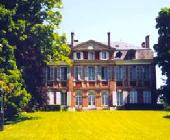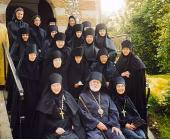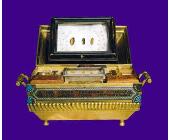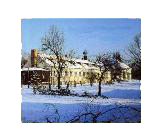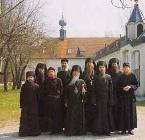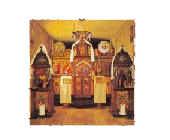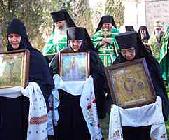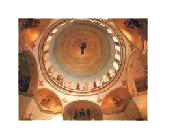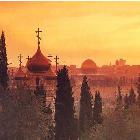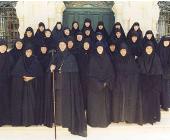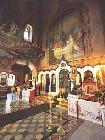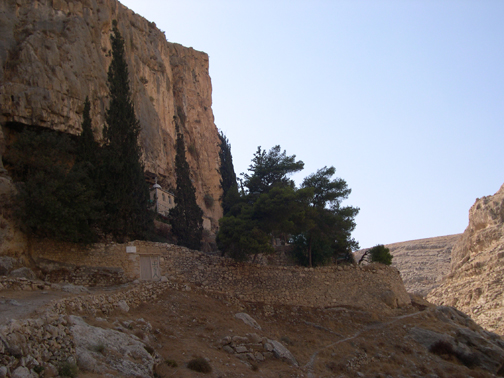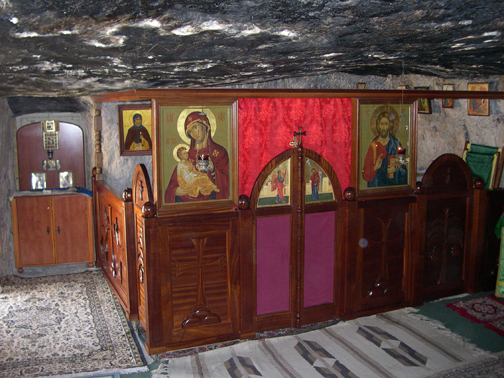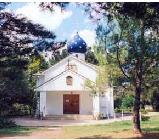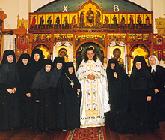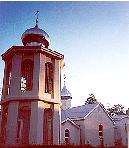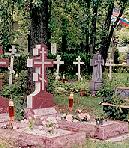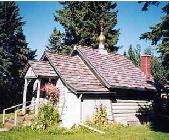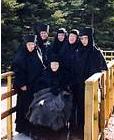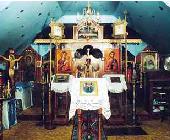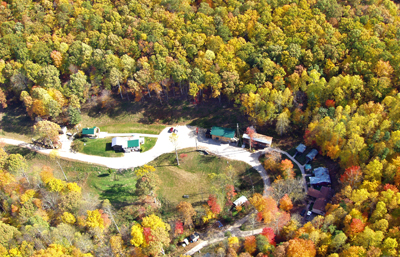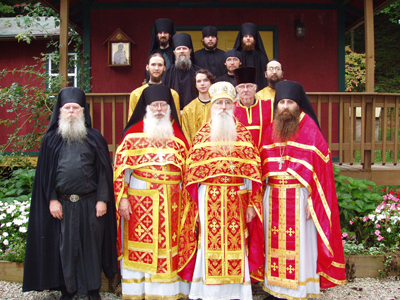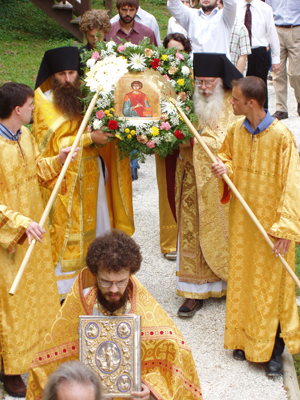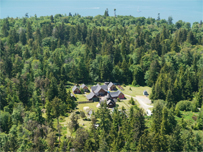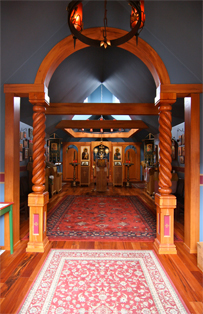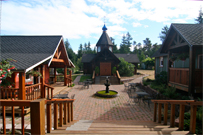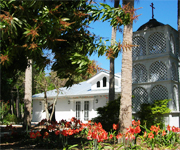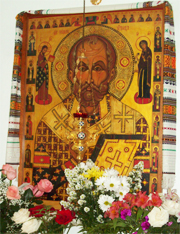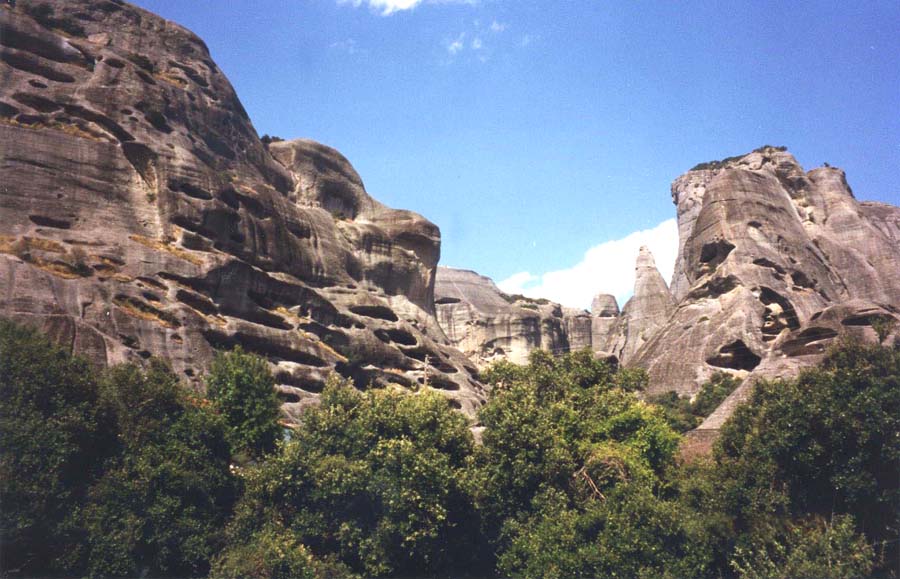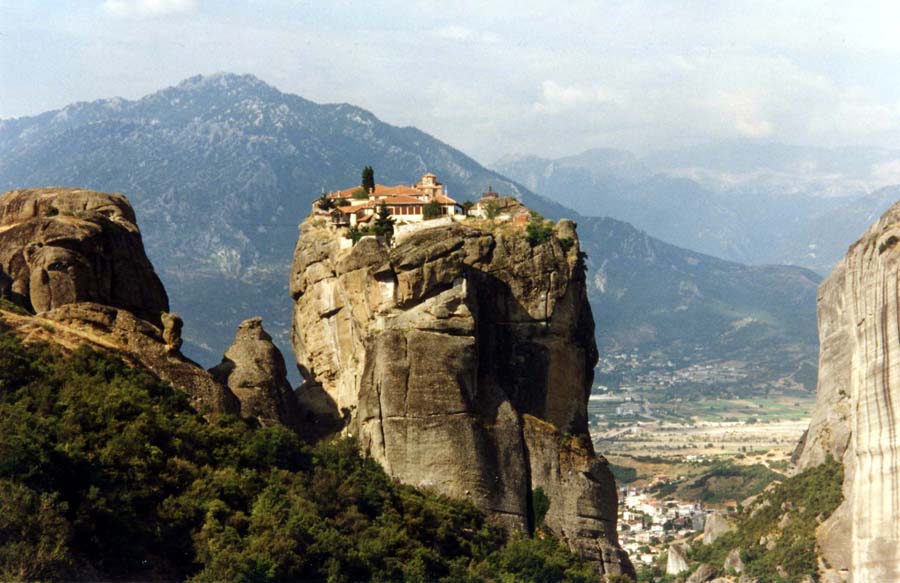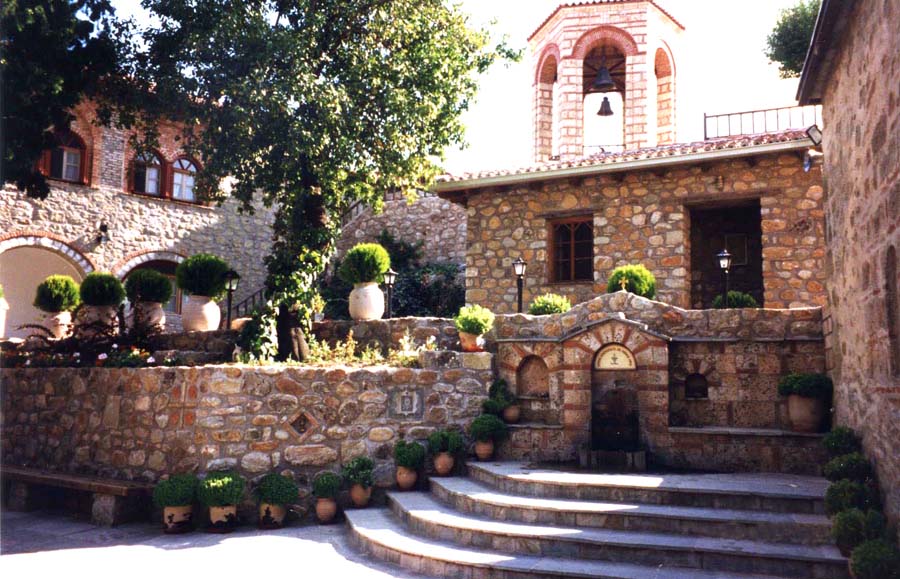
The Lord God blessed the Russian Diaspora to have many monasteries and monastic communities. Some of them moved in their entirety from Russia, for example, Lesna Convent; others became the heirs of the tradition of old Russian monasteries, especially of Pochaev and Valaam; the third kind were established entirely in the New World. The list below is not comprehensive: it does not include all the monastic communities of the Russian Orthodox Church Outside of Russia, but only the main ones.
| |||
Holy Trinity Stavropighial Monastery in Jordanville
The monastery was established in 1930 by Archimandrite Panteleimon. The present Superior is Archimandrite Luke (Murianka). The main church was dedicated to the Holy Trinity; the lower church in honor of St. Job of Pochaev; the cemetery church in honor of the Dormition of the Most-Holy Mother of God, and the church on the lake in honor of the Holy New Martyrs of Russia and of St. John of Rylsk. The Monastery includes a publishing house of St. Job of Pochaev, an icon-painting studio, the Holy Trinity Seminary, a library, a Russian cemetery and a historical museum.
The main holy object of the Monastery is the copy of the Pochaev Icon of the Mother of God. In the cemetery are buried Metropolitans Anastassy and Philaret of blessed memory, Archbishops Tikhon (Troitsky), Appolinarii, Averkii (Taushev), Anthony (Medvedev), Hegumen Filimon of Valaam, the icon-painter Archimandrite Kyprian and the murdered protector of the Myrrh-Streaming Iveron Icon of the Mother of God, brother Joseph. P.O. Box 36 Jordanville, NY 13361-0036, USA Tel: (315) 858-0940; fax: (315) 858-0505 | |||
Lesna Convent of the Most-Holy Mother of God
Provemont, France
The Convent was established in 1885 at the behest of Archbishop Leontii of Warsaw. The first abbess came to Lesna from Moscow along with five nuns. In 1889 the monastic community was reorganized into a general monastery and had town churches in St. Petersburg, Kholma, Warsaw and Yalta. The nuns taught children and the Convent became a center of Orthodoxy outside of Russia. The Royal Family visited the Convent twice. St. Amvrosii of Optina and St. John of Kronstadt were supporters of the Convent. In 1915, the Convent was evacuated into the depths of Russia—all 500 nunsand over 600 others. In 1917, at the invitation of then-Bishop Anastassy (Gribanovsky), the Convent moved to the Kishinev Diocese, and then to Yugoslavia, to Khopovo. From Khopovo, in 1950, the nuns of the Convent left for France (first to Fourquet, then to Provemont), where they remain to this day. In France, the Convent was frequently visited by St. John of Shanghai and San Francisco the Miracle-worker. The main holy object of the convent is the Lesna Icon of the Mother of God. There also are the relics of St. Afanasii of Brest. The nuns bear a multitude of obediences: singing, cleaning, gardening, candle-making, icon-painting, a bookstore, and also warmly greet many visiting pilgrims.
COUVENT DE LESNA
1, rue du Moulin Provemont, 27150 Etrepagny, FRANCE Tel: 33 (2) 32 55 82 66; fax: 33 (2) 32 27 31 75 | |||
Monastery of St. Job of Pochaev, Munich, Germany
The origins of this monastery arose from the Pochaev Lavra. In 1923, the archimandrite of the Pochaev Lavra Vitaly (Maximenko) exported the historical typography of the Lavra to the Carpathian Mountins. There the monastery of St. Job, from 1924 until 1944, furnished all of the Russian Diaspora with service books and spiritual literature. When in 1944, Soviet forces neared the Carpathian monastery, a large portion of the monks left for Germany, then to Switzerland, and finally to Jordanville. Those monks who did not depart for America, along with new novices and monks, gathered around Archimandrite Job in Germany, near Munich. The monastery went through several phases in connection with the decline of monastic life. In 1981, accompanied by the move to the monastery of the ruling bishop of the German Diocese, it has been renewed.
The head of the monastery is Archbishop Mark of Berlin and Germany. The monks manage a variety of obediences: church singing, cleaning, candle-making and publishing.
KLOSTER DES HL. HIOB Hofbauernstr. 26 81247 Muenchen, GERMANY Tel: 49 (89) 834 89 59; fax: 49 (89) 88 67 77 | |||
Mount of Olives Ascension Convent
The plot of land upon which our convent is located was acquired by archimandrite Anthony (Kapoustin) at the end of the 19th c. In 1906 the Convent was recognized by the Holy Synod of the Russian Orthodox Church, and the number of nuns there quickly grew. During the First World War, Jerusalem was declared a war zone and the clergy was expelled. Only in 1919 did the clergy return and the church unsealed. All the care over the preservation of the convent was assumed by the Russian Orthodox Church Outside of Russia. At the convent, besides the Church of the Ascension, are a chapel of St. John the Forerunner and the trapeza church in honor of St. Philaret the Merciful.
The head of the Convent is Abbess Moisseia. The nuns assume many obediences: church singing, cleaning, embroidery in gold and greeting pilgrims.
RUSSIAN CONVENT ON MT. OF OLIVES P.O. Box 19229 Jerusalem 91191, ISRAEL Tel: 972 (2) 628-43-73; Fax: 972 (2) 628-23-67 | |||
Gethsemane Convent, the Church of St. Mary Magdalene
The Church of St. Mary Magdalene was built by Emperor Alexander III in 1888 in memory of his mother. Around this church in Gethsemane Garden in 1934, with the blessing of Metropolitan Anastassy (Gribanovsky), a small monastic community of nuns formed. Some of the nuns established a school in Bethany for Arab girls. Gradually it became possible to organize daily services in Gethsemane and to strengthen monastic life there. The Church of St. Mary Magdalene contains the relics of Grand Duchess Elizabeth Feodorovna the New Martyr and of St. Varvara.
The head of the Convent is Abbess Elizabeth. The nuns have many obediences:
ST. MARY MAGDALENE CONVENT singing, cleaning, tending to children and greeting visitors. P.O. Box 19238 Jerusalem 91191, ISRAEL Tel: 972 (2) 628-43-71; fax: 972 (2) 628-63-81 | |||
Wadi Fara: the Skete of St. Chariton
The Lavra of St. Chariton was the first in the Holy Land. The founder of the monastery in the beginning of the IV c. was St. Chariton the Witness. Now on the place of the lavra is a small men's skete with a cave church. The Skete is under the auspices of the Russian Ecclesiastical Mission in Jerusalem.
THE RUSSIAN ECCLESIASTICAL MISSION IN JERUSALEM P.O. Box 20164 Jerusalem 91200, ISRAEL Tel: 972 (2) 992-88-95 | |||
Russian Orthodox Convent of Our Lady of Kazan "Novoye Shamarino," Australia
The Convent was founded in 1956. With the arrival from China of an enormous number of refugees, including those in monastic orders, a piece of land was purchased and a monastic building and church were built upon it. Mostly elderly nuns settled there. It seemed that the Convent would die out, but in 1980 a stream of youn novices began to join. In 1983 a new church was built in honor of the Kazan Icon of the Mother of God, along with housing. An old-age home was build alongside the Convent with a Russian library.
Nuns perform their obedience by singing, in the garden and in tending to the elderly.
OUR LADY OF KAZAN CONVENT 32 Smith Road Kentlyn, N.S.W. 2560, AUSTRALIA Tel: 61 (2) 4625-7054 | |||
Monastery of St. Edward the Martyr, England

In 1979, Archimandrite Alexei, an Englishman by birth, received a blessing from the Synod of Bishops of the Russian Orthodox Church Outside of Russia to receive the relics of the martyred King Edward and to erect a proper home for them. King Edward, in many ways similar to SS Boris and Gleb the Martyrs, was cruelly martyred in the Xth c. In 1982, a small brotherhood settled at a cemetery in the city of Brookwood, and gradually turned the old Anglican church into an Orthodox one. This church now contains the relics of St. Edward. The Brotherhood conducts services in English, Greek and Church Slavonic and primarily serves the needs of those newly converted to Orthodoxy among the English, and also publishes a journal, The Shepherd.
ST. EDWARDS BROTHERHOOD St. Cyprian's Avenue Brookwood, Woking, Surrey GU24 OBL, ENGLAND Tel: 44 (1483) 487 763; e-mail: theshepherd@mac.com | |||
Stavropighial Convent of the Dormition, "Novo Diveevo"
The Convent is located some 60 km from New York City. The founder and builder of this monastery was Protopresbyter Andrian Rimarenko (starets Nektarii of Optina died under his epitrachelion). In 1949, with the arrival in America of a multitude of refugees, Fr. Adrian decided that it was necessary to have a spiritual center. A former Roman Catholic monastery was built and a Russian convent was founded. Soon after an Orthodox church was built in honor of St. Seraphim of Sarov. The largest Russian Orthodox cemetery is located at the site along with a home for the aged. The convent has many sacred things: a full-length portrait of St. Seraphim of Sarov painted during his lifetime, a cross from the Ipatiev House and the cell icon of the Mother of God that belonged to St. Amvrosii of Optina.
The head of the Convent is Abbess Irina.
RUSSIAN ORTHODOX CONVENT "NOVO DIVEEVO" 100 Smith Road Nanuet, NY 10954, U.S.A. Tel: (845) 356-0425; fax: (845) 356-8250 | |||
New Kursk-Root Icon Hermitage, Mahopac, NY
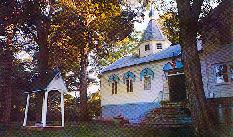
In 1949, some 60 km from New York city a plot of land was purchased for the establishment of a church and summer residence for the First Hierarch of the Russian Orthodox Church Outside of Russia. It was given the name iNew Kursk-Root Hermitage,i in honor of the old Kursk-Root hermitage destroyed by the bolsheviks, where the Miracle-working Kursk-Root Icon was found. A small monastic community grew at the site, which held several Councils. At the present time only a priest and some workers live there.
The Synodal Candle Factory is housed on the property.
RUSSIAN ORTHODOX MONASTERY 1050 Route 6 Mahopac, NY 10541, U.S.A. Tel: (914) 628-4975 | |||
Convent of the Protection of the Mother of God, Bluffton, Canada
At first, in 1953, the Convent was a skete of the Convent of Our Lady of Vladimir in San Francisco. It is located in the far north of the Province of Alberta. Subsequently, due to the decline of monasticism in the Vladimir Convent, the property was handed over to the Diocesan Administration of the Canadian Diocese, and in 1980 a monastic community, now independent, was formed. The Convent has a winter and summer church and a cemetery. There has been a recent influx of young novices.
The head of the Convent is Abbess Amvrosia.
HOLY VIRGIN PROTECTION CONVENT RR #2 Bluffton, AB T0C 0M0, CANADA Tel: (403) 843-6401 | |||
Annunciation Convent in London, England
The Convent was established in 1954 with the blessing of St. John of Shanghai and San Francisco the Miracle-worker for spiritual education. The Convent had its origins in the Holy Land. The head of the Convent with a group of nuns was forced to undergo a barrage of bullets while fleeing their monastery near Jerusalem during the Arab-Israeli war of 1948. The nuns suffered great need, illness and misfortune in their exile for 6 years, until, following 2 years of warm hospitality at Lesna Convent in France, Divine Providence brought them to England.
HOLY ANNUNCIATION CONVENT 26 Brondesbury Park London NW6 7DL, ENGLAND Tel: 44 (181) 459 02 63 | |||
Transfiguration of the Savior Skete, Bombala, Australia
This small monastic community is located in the mountains of Australia. The Skete was founded with the blessing of Archbishop Paul (Pavlov) in 1982. One of the main goals of the Skete is the spiritual nourishment of pilgrims. Not far from the Transfiguration Skete the Presentation Convent was established. The head of the Convent is Abbess Anna.
The head of the Transfiguration Skete is Archimandrite Aleksei.
HOLY TRANSFIGURATION MONASTERY Richardson's Road Bombala, N.S.W. 2632, AUSTRALIA Tel: 61 (2) 6458 3009 | |||
Holy Cross Skete, West Virginia, USA
The Hermitage of the Holy Cross is an English speaking monastic community of the Russian Orthodox Church outside of Russia. The Brotherhood currently includes eight monks, three novices, and candidates for the novitiate.
The Hermitage was founded in 1986 in House Springs Missouri by Hieromonk Kallistos (+1992). After Fr. Kallistos reposed in the Lord, the monastery was accepted as a spiritual dependency of Holy Trinity Monastery in Jordanville, NY. In May of 2000 the community was moved to a rural property in West Virginia. Archimandrite George of Jordanville acts as the spiritual father for the community, which is headed by Hieromonk Seraphim. The brotherhood supports itself through the production of church incense, liturgical chant recordings, soap products, hand-painted icons, and the sale of books and other church goods.
Hermitage of the Holy Cross
RR 2 Box 2343 Wayne, WV 25570-9755 USA Phone - (304)849-2072 Fax - (304)849-2016 www.holycross-hermitage.com/ | |||
Convent of St. Elizabeth, near Jordanville
The Convent was established in the 1980s and attempts to follow the monastic order of SS Martha and Maria in Moscow. The nuns sew vestments, paint icons, and prepare candles and incense.
The head of the Convent is nun Ioanna.
COMMUNITY OF ST. ELIZABETH 1520 State Rte 167 Mohawk, NY 13407, U.S.A. Tel: (315) 858-2208 | |||
All-Merciful Saviour Monastery
English-speaking brotherhood. The Abbot is Igumen Tryphon. All-Merciful Saviour Monastery P.O. Box 2420 Vashon Island, WA 98070-2420, USA Tel: (206) 463-5918 Website: http://www.vashonmonks.com/ | |||
CONVENT OF NATIVITY OF THE VIRGIN MARY
Wayne, WV CONVENT OF NATIVITY OF THE VIRGIN MARY P.O. Box 698 Wayne, WV 25570-0698, USA | |||
MONASTERY OF ARCHANGEL MICHAEL
Tel: (304) 849-4697
Superior of the community: Hieromonk Kosma
P.O. Box 554
Marrickville, N.S.W. 2204 Australia | |||
PRESENTATION SISTERHOOD
Bungarby, NSW, Australia
Superior of the community: Abbess Anna. PRESENTATION SISTERHOOD Rennie's Road Bungarby, N.S.W. 2630, AUSTRALIA Tel: 61 (2) 6453-6272 | |||
SAINT NICHOLAS MONASTERY
Saint Nicholas Monastery is a female monastic community of the Russian Orthodox Church Outside of Russia. The Monastery chapel is dedicated to the Holy Prophet and God-seer Moses. The nuns speak English and Spanish, with Liturgical services celebrated mainly in English and Slavonic. Of the many sacred treasures with which the Monastery is blessed are sacred relics of the Precious Cross of our Lord Jesus Christ, the Veil of the Mother of God, Saint Nicholas, the Holy Apostles, and others. The Archimandrite John Memorial Library houses more than 10,000 volumes. Obediences include iconography, sewing, receiving pilgrims, candle making, library cataloging, and operating a Monastery bookstore. The head of the Monastery is Abbess Andrea
1340 Piney RoadNorth Fort Myers, FL 33903 U.S.A. Tel: 239-997-2847 |



